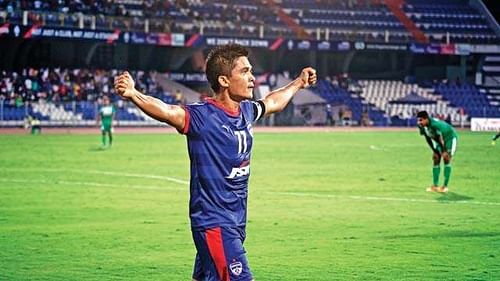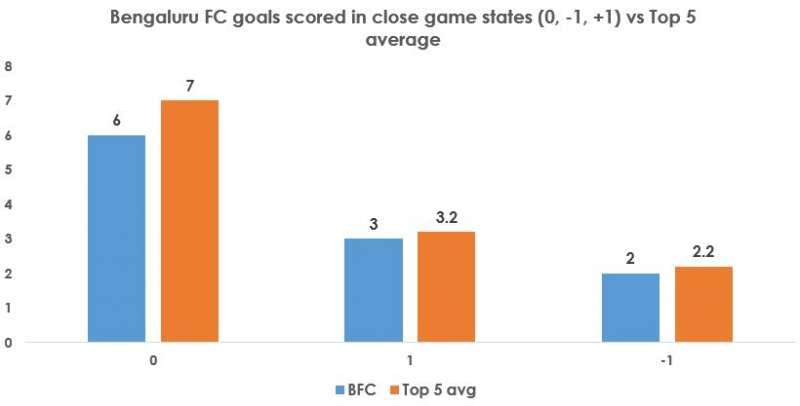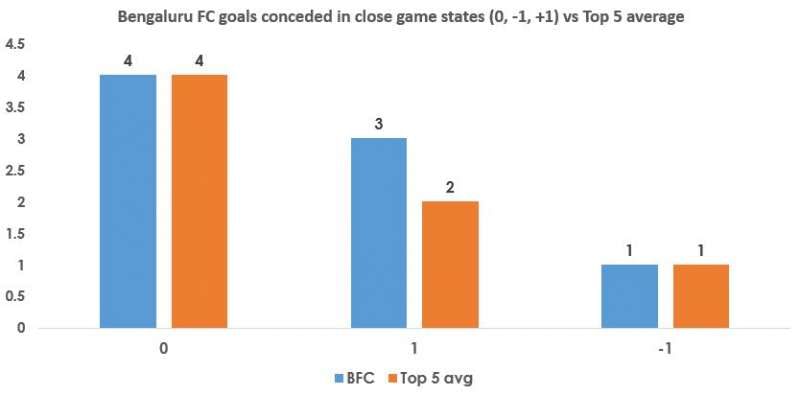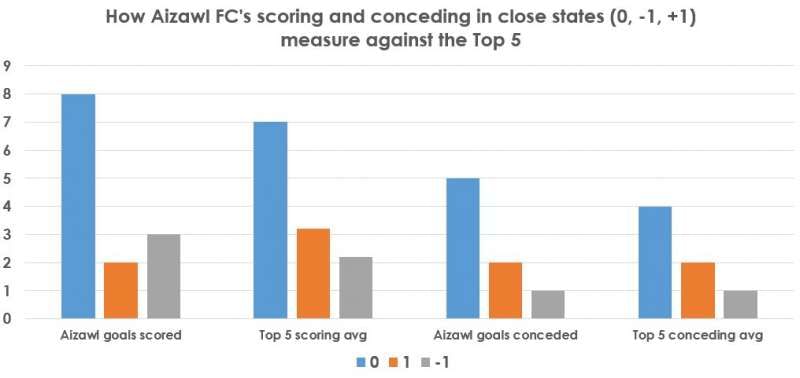
I-League 2017: Analysing title challenging Aizawl, Bengaluru’s slump and ruthless Mohun Bagan
Earlier this month when Bengaluru FC visited Aizawl, their captain Sunil Chhetri had a record within reach. The 32-year-old was a goal short of becoming the all-time top Indian goal-getter in National Football League and I-League history.
What transpired during that game was that Chhetri scored a wonder goal to eclipse Bhaichung Bhutia’s tally of 89 domestic goals. However, he barely celebrated what was a historic moment, instead urging his team-mates to regroup for the ensuing restart.
Bengaluru had endured one of their worst first half displays in Aizawl and trailed by a goal to the high-flying Mizoram outfit. That wasn’t in the script. Bengaluru, the defending I-League champions and AFC Cup runners-up, had been winless in five matches at kick-off. Going behind to Aizawl was the last straw for Chhetri who then took matters into his own hands and equalised with that aforementioned howitzer.
Also Read: What does Sunil Chhetri overtaking Bhaichung Bhutia's goal tally represent?
Trailing by a goal is a game state where the team that is leading happens to sit deeper and protect its lead. Conversely, the trailing team attacks more but often faces low-block defences determined to deny chances to the opposition.
Against Aizawl FC, Bengaluru made a fast start but that didn’t translate into any advantage. Khalid Jamil’s Aizawl settled into the game gradually and were well worth their lead when Brandon Vanlalremdika scored in the 40th minute. Thereafter, Bengaluru desperately tried to equalise, while Aizawl put more men behind the ball.
Often, the trailing team barely gets a clear target on goal owing to the opposition’s defensive compactness. Bengaluru faced similar issues, which were masked by Chhetri’s goal from range which, in top level football, has only a 4–5 percent of being scored.
Game States
Game states are often overlooked in post-match statistics and narratives, but they are a prime indicator of how a team plays during different phases of a football match. For example, had Bengaluru taken an early lead in Aizawl, they would have settled into their passing rhythm without going too gung-ho in attack.
Likewise, at 0–0, Aizawl were more than prepared to take risks to stretch the Bengaluru back-line and at 1–0, they denied space to their opponents. The probability of a long distance goal like Chhetri’s is very low, hence Aizawl can be said to be unlucky to have conceded a goal from an audacious attempt.
There are different game states in which a particular team finds itself during the course of ninety minutes. Following is a brief idea of various game states.
0: a match at 0–0, 1-1, 2-2, etc.; it is the default kickoff state.
+1: team leading by one goal; various scorelines are 1–0, 2–1, 3–2, etc.
-1: team trailing by one goal; various scorelines are 0–1, 1–2, 2–3, etc.
+2/-2: similar to +1/-1 but with a goal differential of 2. Other, higher game states are similar in nature.
Collectively called close states, the 0, +1 and -1 game states are the most common in football, with more than 85 percent of all minutes of football games being in those three states. In this I-League season, close states have accounted for 88 percent of all minutes played thus far.
Case Study: Bengaluru FC’s Slump
The 2017 I-League season has thrown quite a few surprises, not least Bengaluru’s slump in form. At the time of writing, the Blues are languishing in fifth. A mid-table position for league champions is often an unacceptable situation, and that is where Bengaluru find themselves in.
Despite a strong start to the season with three straight wins, Bengaluru haven’t won a game since 18th January. With teams defending in a central block against Albert Roca’s pass masters, breaking down low defensive units has been a problem for Bengaluru this season.
As mentioned earlier, game states have contributed to Bengaluru’s recent poor run of results. Teams tend to retreat to their defensive shells upon taking the lead, making it difficult for Bengaluru to create clear-cut chances.
As the above image shows, there has been a marked difference in the game states between Bengaluru’s first three games and their last six. The Blues won their opening three games fairly comfortably, scoring eight times without conceding. The last six games have been far from straightforward for Roca’s men.
They have been in a positive game state for only 42 minutes in those six games, while concession of goals has meant they have been in -1 state for quite a while. As explained earlier, being a goal down is an unwelcome prospect for Bengaluru, and they have struggled after going behind, leading to their winless run.
Also Read: I-league 2017: Bengaluru FC - the midfield conundrum
Looking at their scoring and conceding data from close states, Bengaluru have managed to score only twice after trailing by a one-goal margin, while they have conceded the second highest number of goals (three) when leading by a one-goal margin.
As the above images show, the fact Bengaluru have been scoring fewer goals in close game states than their top five rivals points to their misfiring attack. Moreover, their defence hasn’t been any better than those of the teams above them; they have even conceded more goals in +1 game state than the average of the league’s top five teams.
An inability to hold a one-goal lead and the lack of edge after going a goal down have been Bengaluru’s undoing so far. Against Aizawl, they came back via a fortuitous equaliser but barely posed a sustained threat thereafter to take the lead, although they had a goal disallowed.
Furthermore, their first three games aside, Bengaluru haven’t built on their one-goal leads; instead, teams have bounced back fairly regularly against the champions. Their early season ruthlessness needs to return, or else they face a disappointing end to their title defence.
Case Study: Title-challenging Aizawl FC
Aizawl FC are, quite surprisingly, third in the league table. Only a point separates Jamil’s side from the two Kolkata giants at the top of the table. Aizawl have gone places this season riding on the back of their good home form.
At home, they have beaten northeastern rivals Shillong Lajong and league leaders East Bengal, and have also denied Bengaluru a win. Their home form has been exemplary as seen from the results, but underlying numbers suggest that hasn’t been by luck or chance. Instead, Aizawl have dominated every opponent they have faced in the altitudes of Mizoram and shown marked improvement game after home game.
80 percent of Aizawl’s points this season has come at home, and with 16 points from six matches, they are the I-League team with the second best home record (2.66 points per game) thus far behind Mohun Bagan (3 points per game).
Shot dominance can be seen as a measure of a team’s greater quality, and it is well established that over a longer period of time, a team that takes more shots will come out on top. However, one downside of drawing conclusions from shot data is that results are decided by goals, not shots, and rather than simulating for a long period, football games are often isolated events.
Exceptions in football, like in everything else, are bound to happen, but more often than not, a team that dominates shot numbers is more likely to win than a team that relies on one attempt for each goal. Total Shots Ratio (TSR) and Shots on Target Ratio (SOTR) are two of the basic metrics used in football analytics to measure shot dominance or to analyse which team is more attacking.
However, one caveat of judging teams solely by shot numbers is that they are dependent on game states. For example, a team in +1 state tends to have more shots on target (number of shots may be fewer) owing to the other team pouring men forward in attack and leaving spaces at the back, while for the team in -1 state, shots on target may be lesser (number of shots may be higher) because the other team may sit back and deny space to shoot.
TSR = number of shots by a team in a game/total number of shots in the game
SOTR = number of shots on target by a team in a game/total number of shots on target in the game
If TSR and SOTR are more than 0.50, it gives a rough idea that the team for which the metrics are measured has been more attacking than its opponent.
This season, at home, Aizawl FC seem to have blown away teams. Their Rajiv Gandhi Stadium has turned into a fortress, and that can be attributed to their ability to attack with efficacy while keeping opponents fairly quiet. Data from Aizawl’s home matches have been supplied by the Mizo sports website, Inkhel.com.
Aizawl’s SOTR’s in their five home games read: 0.67, 0.62, 0.50, 0.67, 0.50, 0.75.
Their home game TSR’s read: 0.63, 0.67, 0.67, 0.77, 0.56, 0.71.
Those numbers make for an average SOTR of 0.62 and average TSR of 0.67 per home game. That can be loosely interpreted as having almost two-thirds of a game’s attack coming from Aizawl and shows how they have offensively dominated every opponent at home.
The last pair of SOTR and TSR of 0.75 and 0.71 are even more impressive considering that they came against East Bengal. If they can dominate the table-toppers in such a way, there is every reason to believe Jamil’s men are title challengers this season.
Talking of game states, Aizawl have had a league highest 96 percent of their minutes played in close states. That suggests they have almost always been in a game. They have spent a league highest 610 minutes in 0 game state, another stat which shows their staying power in games. Twice they have scored late winners, while only four of their 13 goals have come in the first half of matches.
With attacking impetus and greater staying power, Aizawl are clearly in the reckoning for the title. There is a pragmatic streak to the team which means the players get the job done, unlike last season when they finished second from bottom.
However, that is only taking into account numbers from their home matches. Aizawl’s away form hasn’t been great. With four away games left, their onus will be to play with a similar conviction on the road as they have done at home.
Other Game State Takeaways
#1 Mohun Bagan have only spent 13 minutes in -1 game state. That is only 1.6 percent of their total playing time this season. Furthermore, they haven’t been in any other negative game state. Their 240 minutes in +1 games state is the highest so far this season. The Mariners have clinically disposed of their opponents and are firm favourites for the title.
#2 There is a reason why Churchill Brothers are down in the basement. The Goan outfit have conceded a league highest 11 goals in 0 game state, meaning they are almost always on the backfoot. Although they have scored the most number of goals in -1 state to get back level, their knack for conceding at 0 state means their goals at -1 haven’t been of much help. Besides, they have also conceded the most number of goals in +1 state, ceding any advantage they have had after going in front.
#3 East Bengal have enjoyed more time in positive game states (+1, +2, +3…) than any other club this season with 332 minutes. Among the top five, Bengaluru have spent the least amount of time in positive game states with 164 minutes. Shillong Lajong have had the least number of minutes in 0 state, the polar opposite of Aizawl FC.
Notes:
1. Due to the lack of publicly available I-League data, the duration of all the matches is considered to be 90 minutes. The impact of added time in football is considerable, but they cannot be worked with without accurate information. I hope the little deviations caused by that is excused since the whole point of the analysis remains more or less the same with small +/- in minutes.
2. All data are updated till 23rd February 2017




